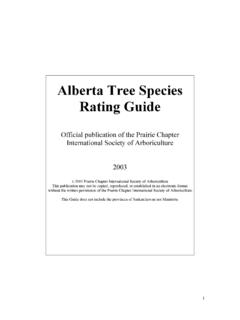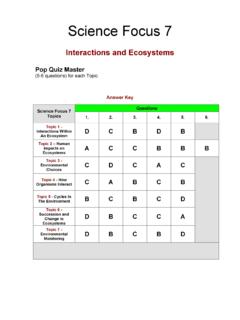Transcription of Forest Ecosystem Classification Guide
1 Introduction toSaskatchewan sForest Ecosystem Classification GuideMichael McLaughlan, Ministry of EnvironmentSaskatoon February 12, 2011 Field Guide to the Ecosites of Saskatchewan s Provincial McLaughlan, Wright, and Jiricka Overview of the Guide Historical context Description of the fact sheet components Example applications for the Guide Availability of the guideFirst Things Acknowledgements Thank-you to the 150+ folks who contributed to the development of this AckermanKathy ActonDianne AllenBill ArchiboldAl ArsenaultBrad AshdownKen BaldwinSid BantingMarcy BastAngela BattisteKrystal BauerJanet BaumanFloyd BearRhys BeaulieuYvonne BenzGeorge BihunMichael BockJoachim BoehmRoger BonneauLillith BrooksCorny BuddLaena BullerBob BuschAndrea BusseAngus CarrJames CaseNed CaseyDave ChabanJoe ChernyshSylvia ChipmanHazel CloakValeria CoenenJames DaigneaultBernie De VriesHenry DesjarlaisJulie DeugauSteven DeugauCarman DodgeKeith DodgeJennifer DoubtDave DowningJames EhnesDon EnsKarla EnsBaosheng FanVerna FedorukJoe GaudryDonovan GauthierVicki GauthierKathleen GazeyLane GelhornAnn GerryGlenda GoertzenWilf
2 GoerwellMike GoodyearGenny GreifDusty GuedoCharlie HarperDiane HaydukewichBrendan HemensMurray HildermanBrian HolmesDick HonchJohn HudsonGerry IvanochkoDarwin JankeMark JohnstonHeather JonesAlex JuorioJack KeelDwayne KeirKirsten KetilsonBea KobialkoMike KryzanowskiHelena LambNadine PenneyAllan LewisDave LindenasCorey LinnenJianwei LiuTim LoranDonna LundquistPat MacKaseyWill MackenziePaul MaczekPaul MasonColin McConnellRory McIntoshStan McKenzieSam McLaughlanDiane McLeodJoe MeehanJose MenezesMo MillerDarrell MisnerKelly MooneyRobert MooreGary NeilJason NelsonVal NicholsonVesna NikolicJennifer NuedorfWendy NumendahlMartha O SullivanRandy OlsenBas OosenbrugBrenda ParenteauCory PedersonBrad PinnoSteve PorterJudy PostleMary PriznikGerry RaceyShawn RegnierTony RichmondMichael RushtonDerek SattlerBarbel Schwab-MoeJason SmithJim SmithTed SnowWill StaffordKietha SwensonRod ThompsonJeff ThorpeMiodrag TkalekBill TowillTim TrottierKen van ReesLouise VersteegBruce WalterKaren WatersPaul WeedonAl WillcocksBob WilsonFloyd WilsonSelena WongBob WynesFritz YungwirthKen Yurach Mr.
3 The Introduction The Instructions The Informative The Immaterial1. ABOUT THIS GUIDEL edum decumbens northern Labrador teaThe Guide :An OverviewIntroduction Saskatchewan s Ecosystem Field Guide : ..can be thought of as an encyclopedia or dictionary of Saskatchewan s provincial Forest ecosystems, but it is not just ..represents the mature, natural, and ambient Ecosystem conditions across our landscapes, ..is cornerstone to results-based management in a natural resource sector environment because it describes the qualitativeand quantitativeattributes associated with our More than Just Forests The Ecosystem Field Guide describes: Forests Coniferous Deciduous Mixedwoods Wetlands Swamps Bogs Fens Marshes Non-treed Conditions Grasslands Dunes Context January, 2004 Meeting in which we obtained input about what Ecosystem attributes would be displayed and what structure and format the Guide would follow.
4 The Guide was shaped by 2 meetings with various resource professionals, and other potential users. May, 2000 Meeting in which we obtained important input about the scope and application of the project. Specifically, it was at this meeting that users told us that they wanted a regionally specific Ecosystem Classification ( ,a separate Classification for each ecozone)..creep !The Introduction 1. About this Guide Purpose, Project Scope & Users 2. Ecological Classification and Forest Ecosystem Classification Hierarchy & Saskatchewan Context 3. Biophysical Context Geographical Location, Geology, Topography & Soils, Climate and Vegetation 4. Development Process Project Planning, Experimental Design, Stratification, Data Management and AnalysisLa RongeReginaPrince AlbertMeadow LakeHudson BayCreightonSaskatoonThe Instructions 5. How to use the Guide Diagnostic species Nested format Ecosite Keys Overview Terrestrial Wetland Non-Forested Explanations & Descriptions of the Fact Sheet Attributes Cautionary NotesThe Informative (& Important) 6.
5 Ecosite Factsheets (81) Taiga Shield Boreal Shield Boreal Plain PrairieThe Immaterial 7. Common & Scientific species Names Harms, (2006). Annotated catalogue of Saskatchewan vascular plants. Fraser Herbarium, University of Saskatchewan, Saskatoon, SK. 116 pp. Anderson, ; Crum, ; Buck, (1990). List of the mossesof North America North of Mexico. The Bryologist, 93(4):448-499 Anderson, (1990). A Checklist of Sphagnumin North America North of Mexico. The Bryologist. 93(4):500-501 Stotler, R.; Crandall-Stotler, B. (1977). A Checklist of the Liverworts and Hornwortsof North America. The Bryologist. 80(3):405-428. Esslinger, T. L. 2009. A cumulative checklist for the lichen-forming, lichenicolous and allied fungi of the continental United States and Canada. North DakotaState University (First Posted 1 December 1997, Most Recent Version # 15 27 Aug. 1997) Fargo, 8. Jurisdiction Synonyms Alberta, Manitoba, Canadian National Vegetation Classification 9.
6 Glossary 10. Literature CitedHistorical Context Ecosystem Classification in Saskatchewan From Palliser to Kabzemsand Beckingham and BeyondCorallorhiza maculata spotted coralroot3. BIOPHYSICAL CONTEXTP alliser Expedition Also called the British North American Exploring Expedition. The expedition explored and surveyed western Canada from 1857to 1860. In 1863 Palliser submitted his report to British Parliament which described the flora, fauna, inhabitants and capabilities of the land for settlement and (expedition botanist)John Palliser -geographer (left)James Hector -naturalist, geologist & surgeon (right)Saskatchewan Soil Survey Following the Swift Current Better Farming conference held in 1920, a Royal Commission was appointed to to assess the farming conditions in southwest Saskatchewan. Led by the University of Saskatchewan Soil Science Department, the first survey covered four s near Moose Jaw in 1921.
7 In 1950 the work was expanded with more detailed mapping and for the next 40 years, crews (of 10 to 20 people) set out to collect information about the province s soils and ecosystems. So after only 80 short years, the task was complete and Saskatchewan s Soil Survey is perhaps the longest-running project undertaken to understand Saskatchewan's Regions of SK Originally produced in 1983(and revised in 1989). Contributing authors were: Wayne Harris, Alf Kabzems, Adam Kosowan Glen Padbury Stan Rowe Recognized 6 ecoregions and 13 ecodistricts based on climate, physiography, and vegetation. Described the ecoregions according to their climate, terrain features, vegetation, wildlife, resources, and land of Saskatchewan Poster map was produced in 1994. Identifies 11 ecoregions and 157 Landscape areas (ecodistricts). Is consistent & compatible with the Canadian ecozones & ecoregions. Formed the basis for the Department of Environment secological operation framework (ecoregional structure) in Level Classification Has occurred in the form of botanical investigations describing plant associations and sub-associations for quite some time.
8 Examples include: George Argus. 1966. Botanical investigations in northeastern Saskatchewan: The Subarctic Patterson-Hasbala Lakes region. Vern Harms. studies in the boreal Forest along the Green Lake-La Loche road, Northern Saskatchewan. Zoheir Abouguendia, Bob Godwin & Dan Richert. 1979. Botanical investigations along the proposed Key Lake Red Book Formally know as the Field Guide to the Ecosites of the Mid-boreal Ecoregions of Saskatchewan. Produced in 1996(Natural Resources Canada) by: John Beckingham Darrin Nielsen Vince Futoransky Classifies and describes: 13 ecosites (a through m) 29 ecosite phases 78 plant community typesToday The field Guide was finally published in 2010 after approximately 10 years of project planning, data collection, multivariate analysis, and compilation. It was built on data from approximately 2000 plots. Is supported by a comprehensive database. Provides a consistent nomenclature for Saskatchewan s ecosystems.
9 Concisely describes the ecosystems in 81 fun-filled fact theFact SheetsAnemone patens Prairie crocusHOW TO USE THE Guide Ecosite Factsheets (81) Taiga Shield (17) Boreal Shield (27) Boreal Plain (28) Prairie (9)The Fact part 1 Ecosite title (& code) Site Silhouette Edatope Description & sample size Characteristic species By physiognomy & richnessThe Fact 2 Site features Soil profile Ecozonal synonyms Forest productivity Ecological interpretationEcosite Profile Conveys information about the site: Substrate & proportion Slope Shrub understory Tree species Composition Canopy Cover Height (avg. & )BS11 The Edatopic Grid The SK FEC edatope is not so typical. It represents the ecosite position on a matrix of moisture regime and vascular plant species richness. The sum of the richness values in the characteristics species section correspond to the relative position of the ecosite on the BP12 has:Moisture Regime = Richness = details available at: The workshop explores and explains all of the details and nuances associated with correctly interpreting the ecosite Guide .
10 Training locations are planned as follows:Date LocationTBDP rince AlbertTBDR eginaTBDS askatoonTBDM eadow LakeTBDH udson BayTBDLa RongeTBDC reightonApplicationsExamples of Applications of the Guide and Future DirectionPholiota limonella Golden Pholiota ShroomHOW TO USE THE GUIDEA pplication-Site Restoration The most obvious use of the Guide is to use the ecosite description and list of characteristic species to identify the required species for reclaiming and restoring ecosystems following disturbance. This example illustrates how the Guide not only supports, but is fundamental to results-based Articulate expected results, Inform and facilitate decision-making, Foster collaboration among agencies, Provide benchmarks or targets that communicate the desired condition, Are based on quantifiable measures of indicators, and are Linked to the strategic goals of an field Guide represents a tangible example of a results-based approachThe field Guide communicates both qualitative and quantitative features about our ecosystems for the purpose of improved land Habitat Definition Each ecosite can be interpreted as habitat for any number of species .







